Filtered By: Lifestyle
Lifestyle
Frescoes from the rubble of Bohol's quake-hit churches
Text & photos by YASMIN D. ARQUIZA, GMA News
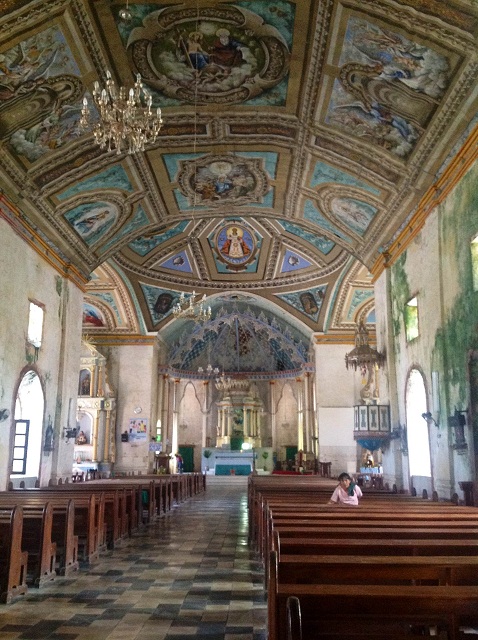 She was wiping the dust from the seats, a solitary figure among the rows of empty pews, when my friend and I entered the church on a sunny weekday afternoon last July. We had not planned on coming here—the Simbahan ng Santisima Trinidad ng Loay—but since it was a short walk from the heritage Clarin House, we decided to take a peek anyway and were not disappointed.
She was wiping the dust from the seats, a solitary figure among the rows of empty pews, when my friend and I entered the church on a sunny weekday afternoon last July. We had not planned on coming here—the Simbahan ng Santisima Trinidad ng Loay—but since it was a short walk from the heritage Clarin House, we decided to take a peek anyway and were not disappointed. Built in 1822, the narrow church had paintings depicting biblical scenes on the ceiling. Above the altar, a delicate pattern of crosses and curlicues on a half-dome frame gave a touch of whimsy to the colonial era structure. A sign near the entrance said the church is an important example of Philippine-Spanish architecture, earning it the status of National Historical Landmark in 2003.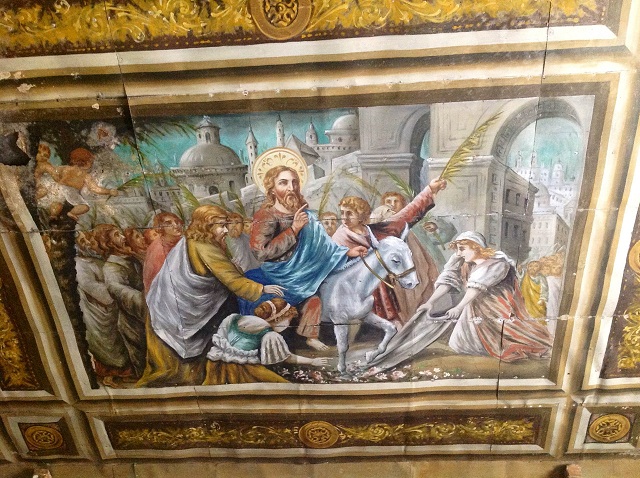
In contrast to the well-maintained center aisle, moss-green splotches were creeping across the bare stone walls. Like the other churches we were visiting that day, the Loay church had a side pulpit near the altar, a pipe organ, and choir loft propped up by tall columns.

In contrast to the well-maintained center aisle, moss-green splotches were creeping across the bare stone walls. Like the other churches we were visiting that day, the Loay church had a side pulpit near the altar, a pipe organ, and choir loft propped up by tall columns.
The cleaning lady, who had given us a not-so-subtle hint about her “volunteer work” when we entered, smiled gratefully as we handed her a small bill before we left.
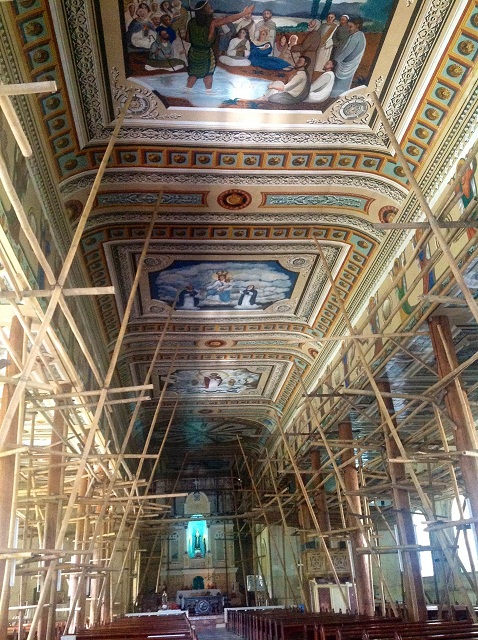 Earlier, we had visited the Santa Monica parish church in Alburquerque, which is reputed to have some of the most well-preserved frescoes in Bohol. Bamboo scaffolding criss-crossed the columns separating the middle and side aisles in the much bigger church, which was under restoration. The paintings of saints and other religious themes were indeed much clearer here, giving the viewer a deeper appreciation for the devoutly Catholic traditions of the province.
Earlier, we had visited the Santa Monica parish church in Alburquerque, which is reputed to have some of the most well-preserved frescoes in Bohol. Bamboo scaffolding criss-crossed the columns separating the middle and side aisles in the much bigger church, which was under restoration. The paintings of saints and other religious themes were indeed much clearer here, giving the viewer a deeper appreciation for the devoutly Catholic traditions of the province.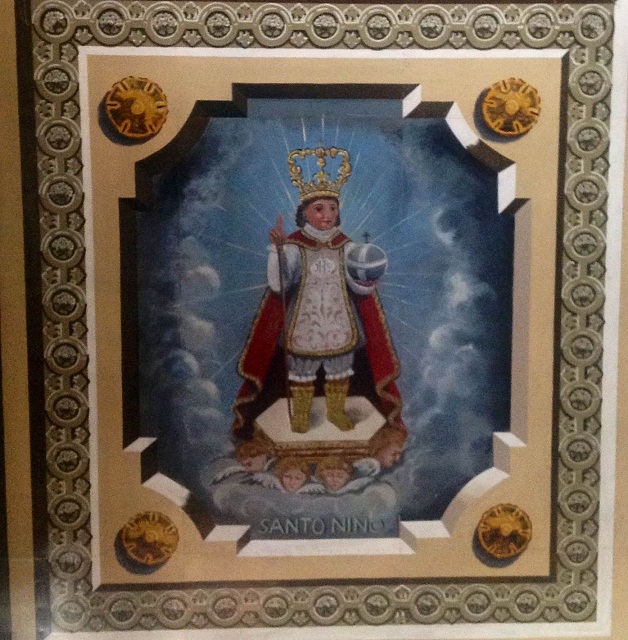
The massive stone structure was equally impressive, the symmetry of its archways and a bridge connecting the church to an annex providing dramatic details that were absent in other churches. In the afternoon heat, the portico provided welcome relief as we admired the artistry of the stunning complex.
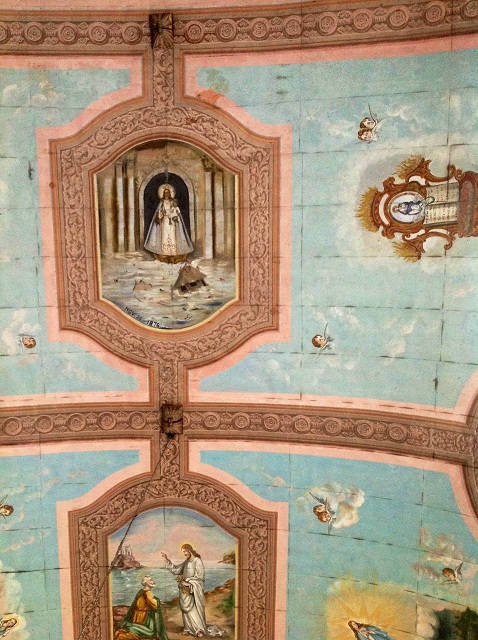 Our last stop before the must-see tarsiers and Chocolate Hills was the Church of San Pedro Apostol in Loboc, a Jesuit-built structure that took more than half a century to complete, from 1670 to 1734. Designated as a National Cultural Treasure, it sits right across the street from the serenely flowing Loboc River.
Our last stop before the must-see tarsiers and Chocolate Hills was the Church of San Pedro Apostol in Loboc, a Jesuit-built structure that took more than half a century to complete, from 1670 to 1734. Designated as a National Cultural Treasure, it sits right across the street from the serenely flowing Loboc River. Just like Loay and Albur, the church in Loboc featured painted ceilings, the biblical scenes floating on a heavenly blue sky complete with billowing white clouds and adorable cherubs. But unlike Loay, this one had clean and well-maintained walls, signs of a more prosperous parish perhaps?
 On each side chapel there were tiered altars, each recessed shelf holding the statue of a religious figure flanked by ornate double pillars. The brightly painted shapes brought back memories of years spent in catechism classes, long forgotten images that will always be associated with church grandeur.
On each side chapel there were tiered altars, each recessed shelf holding the statue of a religious figure flanked by ornate double pillars. The brightly painted shapes brought back memories of years spent in catechism classes, long forgotten images that will always be associated with church grandeur. Sadly, the 17th-century San Pedro church of Loboc was one of the heritage structures that suffered the most from the 7.2-magnitude quake that struck Bohol in the early hours of October 15. A report from Agence France-Presse said the once majestic church had “entirely caved in, as if a giant fist had punched it from above.”
The façade of Loay Church came crumbling down too, a Reuters photo showed. My thoughts went to the cleaning lady, hoping she escaped unscathed. The bell tower, built in 1865, survived the powerful quake.
But why grieve over the remnants of the Spanish colonial era? Why mourn the symbols of the Catholic conquest, whose negative influence remains pervasive in the divisive issues of women’s reproductive health and family life?
"It is like part of the body of our country has been destroyed," the AFP report quoted Michael Charleston "Xiao" Chua, a history lecturer at De La Salle University in Manila, as saying.
Although the structures might still be restored, Chua notes, "What is truly lost are the paintings. The paintings can never be recovered."
But there is hope.
Writing for the news website Rappler, Bohol resident and cultural advocate Edeliza Macalandag reported that there was “little damage” in the Albur Church. “Integrity still intact,” she writes, “but the people pointed us to their homes by the coastline.”
There's also Project Kisame from Task Force Heritage—a group composed of the National Commission on Culture and the Arts, the National Museum, and other cultural heritage conservationists that are making a heroic effort to document the extensive ceiling art of the country's old churches.
There's also Project Kisame from Task Force Heritage—a group composed of the National Commission on Culture and the Arts, the National Museum, and other cultural heritage conservationists that are making a heroic effort to document the extensive ceiling art of the country's old churches.
Not quite flowers – as a book of literary essays once put it – these digital frescoes dug up from the ruins of centuries-old churches. But as long as there are people who have faith, church-inspired art will live on. – With a report from Agence France-Presse/KG, GMA News
More Videos
Most Popular



